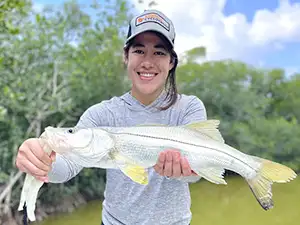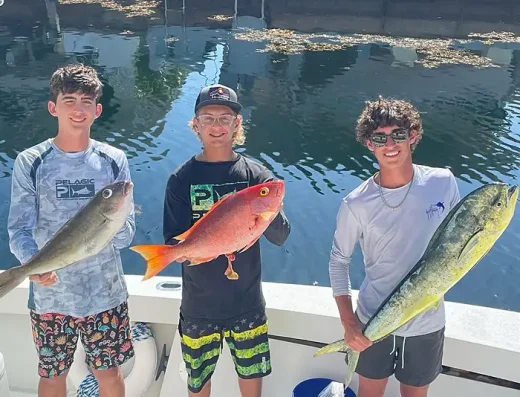Tavernier Fishing Charters
Tavernier fishing charters give anglers fast access to Florida Bay’s backcountry waters, patch reefs, and offshore ledges where bonefish, mahi, and grouper all come into play.
Top Rated Charters in Tavernier
TrustedFish connects anglers with proven local captains in Tavernier, Florida —no commissions, no pay-to-play listings, no BS. Every charter on our platform is invite-only, vetted for skill, local knowledge, and reputation. If they’re listed, they’ve earned it.
Tavernier, FL Fishing Guide
Tavernier sits right in the middle of one of the most dynamic stretches of water in the Florida Keys. Sandwiched between Key Largo and Islamorada, this small community offers immediate access to both the Atlantic Ocean and Florida Bay via Tavernier Creek—a strategic launch point that lets charter captains hit backcountry, reef, and bluewater zones with minimal run time.
Most fishing charters out of Tavernier are half-day or 6-hour trips, with full-day offshore or mixed-bag options also common. The inshore scene here revolves around Florida Bay’s maze of mangrove islands, flats, and channels. This is classic backcountry fishing—calm, shallow water, light tackle, and stealth. Expect to target redfish, snook, sea trout, tarpon, and bonefish depending on time of year and tides. Many captains sight-fish the flats using spinning gear or fly rods, especially during the spring and fall when visibility and fish movement align.
To the east, the patch reefs and deeper ledges start just a few miles from shore. These reefs are loaded with yellowtail snapper, mangrove snapper, mutton snapper, grouper (red and black), porgies, and the occasional mackerel or cobia. Light tackle bottom fishing with live shrimp or cut baits on knocker rigs or jigheads is standard, and the action can be nonstop when the current’s moving right. These reef trips are ideal for anglers looking for a steady bite and the chance to take home fresh fish.
Offshore, captains push 10–25 miles into bluewater for mahi-mahi, blackfin tuna, sailfish, and in some cases, swordfish. The Gulf Stream’s edge, offshore humps, and floating weedlines are the primary targets. Trolling ballyhoo, chumming with live pilchards, and vertical jigging are common tactics. Offshore trips usually start early and run full-day to make the most of the conditions and distance.
Because Tavernier sits near Everglades waters, some guides offer true wilderness-style trips into the backcountry using technical poling skiffs or shallow-draft bay boats. These are often fly or artificial-only trips that focus on sight-casting to snook, baby tarpon, redfish, or even permit.
This diversity is what makes Tavernier special. Within 20 minutes of leaving the dock, you can be stalking bonefish on a quiet flat, anchored over a snapper hole, or chasing mahi under birds offshore. Whether you’re a seasoned angler looking to dial in the tides or a family hoping to bend rods and bring home dinner, the range of water here offers something for everyone.
Fishing Seasons in Tavernier
Spring
This is one of the most productive times to fish Tavernier. Bonefish return to the flats in numbers, especially on warming tides with good sun. Tarpon begin staging in channels and bridges, and the first pushes of mahi appear offshore. Reef fishing heats up with yellowtail snapper and keeper grouper in shallower water. It’s a great season for mixed-bag trips, with light winds and active fish.
Summer
The summer bite favors early mornings before the heat kicks in. Tarpon remain active at dawn near the bridges, and snook feed aggressively along mangrove shorelines. Offshore, mahi are the main attraction—look for them under weed patches or floating debris. Reef fishing remains strong, especially for mutton snapper and mangrove snapper on deeper spots. Calm seas make it easier to reach the humps for tuna or drop for deep-water species.
Fall
This season brings cooler temps and a shift in species. Redfish and snook move deeper into the creeks and shorelines of Florida Bay. Sea trout school up in potholes and deeper grass flats. Snapper fishing remains excellent, with muttons and yellowtail active on the outer reef. Offshore slows slightly for mahi but picks up for blackfin tuna and the first sailfish of the season. It’s a great time for inshore and reef trips, especially after a mild front.
Winter
When cold fronts blow in, the backcountry remains a productive refuge. Sea trout, redfish, and snook bunch up in protected basins and creeks. Reef fishing dominates—yellowtail snapper bite well with shrimp or cut bait, and grouper are more active in cooler water. Offshore action turns to sailfish, particularly on live bait fished under a kite. It’s a season that rewards flexible anglers who can adjust to weather and target structure-focused species.
Gamefish in Tavernier
- Tarpon – 40–120+ lbs Targeted March through July in backcountry channels, bridges, and basins. Fished with live crabs, mullet, or swimbaits on 60–80 lb leader.
- Bonefish – 3–8 lbs Found on clear shallow flats during warm, calm conditions. Sight-cast with shrimp, jigs, or flies on light tackle and quiet approaches.
- Snook – 5–20 lbs Caught in creeks, mangroves, and around structure. Top baits include pilchards, jerkbaits, and soft plastics, especially on moving tides.
- Redfish – 4–12 lbs Backcountry species that favor shorelines and oyster bars. Commonly caught on cut mullet, shrimp, or artificial paddletails.
- Snook – 5–20 lbs Caught in creeks, mangroves, and around structure. Top baits include pilchards, jerkbaits, and soft plastics, especially on moving tides.
- Sea Trout – 1–4 lbs Active in grassy basins and potholes during cooler months. Targeted with popping corks, shrimp, or jig and plastic combos.
- Mahi-Mahi – 5–25 lbs Offshore species found May–August under weedlines and floating debris. Caught trolling ballyhoo or casting jigs to visual targets.
- Blackfin Tuna – 10–25 lbs Best around offshore humps and deep structure. Chummed with live pilchards or caught on vertical jigs.
- Sailfish – 30–60 lbs Peak in winter and early spring. Often caught kite fishing or slow-trolling live baits near color changes and current
- Grouper (Red & Black) – 8–30 lbs Found on ledges and reefs year-round. Fished with live pinfish or cut bait on heavy bottom rigs.
Tavernier Fishing FAQs
What types of fishing charters are available in Tavernier?
Tavernier offers inshore, reef, and offshore fishing charters. Most trips are 4–6 hours, though full-day offshore runs and specialty fly fishing or backcountry trips are also available.
Where do most Tavernier charters depart from?
Most boats launch from Tavernier Creek Marina or private docks nearby. This gives fast access to both Florida Bay and the Atlantic Ocean without long idle times.
Do Tavernier guides provide all the gear?
Yes, all tackle, bait, and fishing licenses are typically included in your charter. Captains also provide coolers and ice. You just need to bring food, drinks, sunscreen, and polarized sunglasses.
Is inshore or offshore fishing better in this area?
Both are productive—it depends on the season and your goals. Inshore is great for light tackle action and scenery; offshore offers bigger fish and more variety.
When is tarpon season near Tavernier?
Tarpon fishing is best from March through July, especially around moon phases and tide changes. They’re often found in the channels and bridge passes.
How long does it take to reach offshore fishing spots from Tavernier?
Most offshore runs are 10 to 25 miles, depending on weather and target species. The Gulf Stream and humps are within reach on full-day trips.
Can I keep fish I catch on a Tavernier charter?
Yes, many species can be kept within state limits. Captains will guide you on what’s legal and will clean and bag your catch at the dock.
Is fly fishing possible in Tavernier?
Absolutely. Many local guides specialize in fly fishing the flats for bonefish, tarpon, and permit. Calm days with good visibility are ideal.
Are the reefs close to Tavernier good for beginners?
Yes, reef trips are great for novice anglers and families. The action is steady, the runs are short, and there’s always a chance at tasty snapper and grouper.


